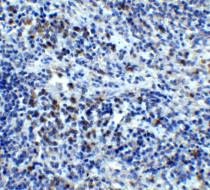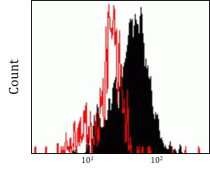ARG54316
anti-CXCR4 (extracellular loop) antibody
anti-CXCR4 (extracellular loop) antibody for Flow cytometry,IHC-Formalin-fixed paraffin-embedded sections,Western blot and Human,Mouse
Cancer antibody; Developmental Biology antibody; Immune System antibody; Metabolism antibody; Microbiology and Infectious Disease antibody; Neuroscience antibody
Overview
| Product Description | Rabbit Polyclonal antibody recognizes CXCR4 (extracellular loop) |
|---|---|
| Tested Reactivity | Hu, Ms |
| Tested Application | FACS, IHC-P, WB |
| Host | Rabbit |
| Clonality | Polyclonal |
| Isotype | IgG |
| Target Name | CXCR4 (extracellular loop) |
| Antigen Species | Human |
| Immunogen | Synthetic peptide corresponding to aa. 182-196 in the second extracellular loop (EL) of Human CXCR4. |
| Conjugation | Un-conjugated |
| Alternate Names | Lipopolysaccharide-associated protein 3; LAP-3; LAP3; Stromal cell-derived factor 1 receptor; Leukocyte-derived seven transmembrane domain receptor; WHIMS; NPY3R; SDF-1 receptor; Fusin; LPS-associated protein 3; HM89; HSY3RR; FB22; NPYR; CD antigen CD184; LCR1; NPYY3R; WHIM; D2S201E; C-X-C chemokine receptor type 4; LESTR; CXC-R4; CD184; NPYRL; CXCR-4 |
Application Instructions
| Application Suggestion |
|
||||||||
|---|---|---|---|---|---|---|---|---|---|
| Application Note | Western blot: use at 1:500 - 1:1,000 dilution. * The dilutions indicate recommended starting dilutions and the optimal dilutions or concentrations should be determined by the scientist. |
||||||||
| Positive Control | HeLa |
Properties
| Form | Liquid |
|---|---|
| Purification | Protein A purified |
| Buffer | PBS (pH 7.4) and 0.02% Sodium azide |
| Preservative | 0.02% Sodium azide |
| Storage Instruction | For continuous use, store undiluted antibody at 2-8°C for up to a week. For long-term storage, aliquot and store at -20°C or below. Storage in frost free freezers is not recommended. Avoid repeated freeze/thaw cycles. Suggest spin the vial prior to opening. The antibody solution should be gently mixed before use. |
| Note | For laboratory research only, not for drug, diagnostic or other use. |
Bioinformation
| Database Links | |
|---|---|
| Gene Symbol | CXCR4 |
| Gene Full Name | chemokine (C-X-C motif) receptor 4 |
| Background | Human immunodeficiency virus (HIV) and related viruses require coreceptors in addition to CD4 to infect target cells. Some G protein-coupled receptors in the chemokine receptor family, including CCR5, CXCR4, CCR3, CCR2b, and CCR8 in the chemokine receptor family, have been identified as HIV coreceptors. CXCR4 (also called Fusin, LESTR, HUMSTR) is a principal coreceptor for T-cell tropic strains of HIV-1. CXCR4 is also required for the infection by dual-tropic strains of HIV-1 and mediates CD4-independent infection by HIV-2. The α-chemokine SDF-1 is the ligand for EXCR4 and prevents infection by T-cell tropic HIV-1. CXCR4 associates with the surface CD4-gp120 complex before HIV enters target cells. The amino-terminal domain and the second extracellular loop of CXCR4 serve as HIV binding sites. CXCR4 messenger RNA levels correlate with HIV-1 permissiveness in diverse human cell types. Antibodies to CXCR4 may block HIV-1 and HIV-2 infection of human target cells. |
| Function | Receptor for the C-X-C chemokine CXCL12/SDF-1 that transduces a signal by increasing intracellular calcium ion levels and enhancing MAPK1/MAPK3 activation. Acts as a receptor for extracellular ubiquitin; leading to enhanced intracellular calcium ions and reduced cellular cAMP levels. Involved in hematopoiesis and in cardiac ventricular septum formation. Also plays an essential role in vascularization of the gastrointestinal tract, probably by regulating vascular branching and/or remodeling processes in endothelial cells. Involved in cerebellar development. In the CNS, could mediate hippocampal-neuron survival. Acts as a coreceptor (CD4 being the primary receptor) for HIV-1 X4 isolates and as a primary receptor for some HIV-2 isolates. Promotes Env-mediated fusion of the virus. Binds bacterial lipopolysaccharide (LPS) et mediates LPS-induced inflammatory response, including TNF secretion by monocytes. [UniProt] |
| Research Area | Cancer antibody; Developmental Biology antibody; Immune System antibody; Metabolism antibody; Microbiology and Infectious Disease antibody; Neuroscience antibody |
| Calculated MW | 40 kDa |
| PTM | Phosphorylated on agonist stimulation. Rapidly phosphorylated on serine and threonine residues in the C-terminal. Phosphorylation at Ser-324 and Ser-325 leads to recruitment of ITCH, ubiquitination and protein degradation. Ubiquitinated by ITCH at the cell membrane on agonist stimulation. The ubiquitin-dependent mechanism, endosomal sorting complex required for transport (ESCRT), then targets CXCR4 for lysosomal degradation. This process is dependent also on prior Ser-/Thr-phosphorylation in the C-terminal of CXCR4. Also binding of ARRB1 to STAM negatively regulates CXCR4 sorting to lysosomes though modulating ubiquitination of SFR5S. Sulfation on Tyr-21 is required for efficient binding of CXCL12/SDF-1alpha and promotes its dimerization. Tyr-7 and Tyr-12 are sulfated in a sequential manner after Tyr-21 is almost fully sulfated, with the binding affinity for CXCL12/SDF-1alpha increasing with the number of sulfotyrosines present. Sulfotyrosines Tyr-7 and Tyr-12 occupy clefts on opposing CXCL12 subunits, thus bridging the CXCL12 dimer interface and promoting CXCL12 dimerization. O- and N-glycosylated. Asn-11 is the principal site of N-glycosylation. There appears to be very little or no glycosylation on Asn-176. N-glycosylation masks coreceptor function in both X4 and R5 laboratory-adapted and primary HIV-1 strains through inhibiting interaction with their Env glycoproteins. The O-glycosylation chondroitin sulfate attachment does not affect interaction with CXCL12/SDF-1alpha nor its coreceptor activity. |
Images (3) Click the Picture to Zoom In
-
ARG54316 anti-CXCR4 (extracellular loop) antibody IHC-P image
Immunohistochemistry: Human spleen stained with ARG54316 anti-CXCR4 (extracellular loop) antibody at 5 μg/mL dilution.
-
ARG54316 anti-CXCR4 (extracellular loop) antibody WB image
Western blot: U-87 stained with ARG54316 anti-CXCR4 (extracellular loop) antibody at 1 μg/mL dilution.
-
ARG54316 anti-CXCR4 (extracellular loop) antibody FACS image
Flow Cytometry: stained with ARG54316 anti-CXCR4 (extracellular loop) antibody at 4μg/mL dilution.








